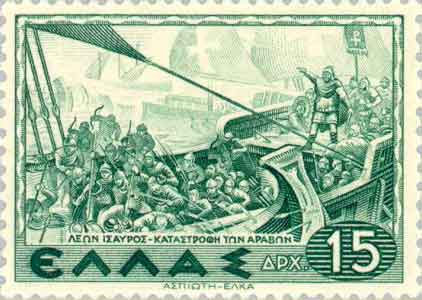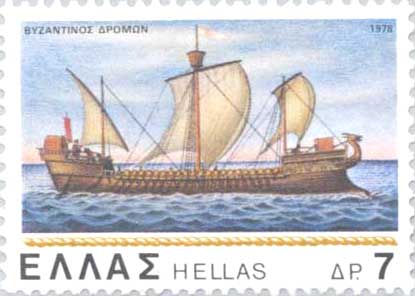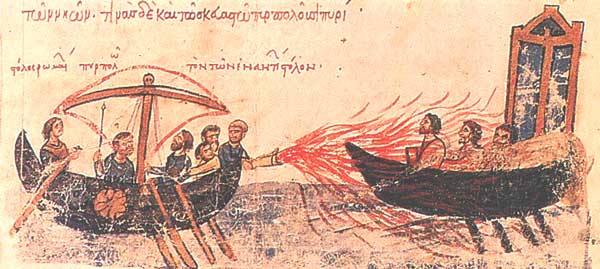|
|
The Byzantine Empire also known as the Eastern Roman Empire, the Byzantine Empire is a modern histiographical term to describe the Roman Empire in later years. Although the Eastern Empire was a direct continuation of the Roman empire begun by Augustus, it developed its own unique culture and identity that in hindsight, appears to be Roman only in name. As such Byzantine is used to seperate the historical periods between the Latin-speaking, pagan Roman empire centred at Rome during the Ancient years, from the Greek-speaking Christian Roman Empire during the Middle Ages, centred at its capital in Constantinople. Whilst there is disagreement on when the Byzantine empire actually started, the age of the Empire is conventionally determined by using the founding of Constantinople in 330AD, until its fall 1,123 years later. Essential to the success of the Byzantine Empire as one of the longest surviving in history, was due to its navy. Early period The Byzantine navy, like the Byzantine Empire itself, was a continuation of the earlier Roman Empire model. In 323 AD the Emperor Constantine defeated a fleet of 350 triremes of the Eastern Emperor Licinius with a fleet of 200 liburnians, smaller and lighter than Roman triremes. In the early period by its organizational structure and technology is similar to Roman Navy.While the Vandal kingdom of Carthage lasted (428-534), the eastern emperors were compelled to attend to their fleet. The new threat came from the Arabs who were desert people but eventually mastered naval warfare and conquered much of the large Mediterranean islands.
Leon the Isaurian against the Arabs Macedonian Dynasty The Byzantine navy reached its highest point under the able sovereigns of the Macedonian dynasty (867-1056). It was divided into the imperial fleet, commanded by the Great Drungarios, the first recorded lord high admiral, and the provincial or thematic squadrons, under their strategoi. Of these there were three, the Cibyrhaeotic (Cyprus and Rhodes), the Samian and the Aegean. The thematic squadrons were maintained permanently for police purposes. The imperial fleet, which was more powerful when in commission than all three, was kept for war. A peculiar feature of the Byzantine navy was the presence in it of a corps answering to the seaman gunners and gunnery officers of modern navies. These were the siphonarioi, who worked the siphons (aujxaves) used for discharging the Greek fire.
Late period By the end of 11th century the principal naval enemies are the Normans from south Italy. However the navy had deteriorated hopelessly and the emperors were driven to rely on the help of the Venetians, and later Genoese. This was amplified after the end of 13th century (previously being conquered by the Fourth Crusade and subsequently restored as a weakened empire). After the restoration the first emperors wrongly assumed that by relying on the naval strength of their Genoese allies they could completely do without the maintenance of a fleet with its particularly heavy expenditure. The efforts of rebuilding the navy under Andronicus III failed.
Ships
Literary sources and accounts reveal that there were at least three varieties of Dromon. These were, firstly the Ousiako which took its name from one company or Ousia of one hundred men. This was a two banked galley with the lower rank rowing only, and the upper rank rowing or disengaging to fight when required. Secondly the slightly larger the Pamphylos with a crew of between 120-160. Secondly the Dromon proper, which had a crew of two hundred, fifty on the lower bank, and one hundred on the upper bank in two files, together with fifty marines. A description of some of the ships is given by Anna Komnene: The emperor knew that the Pisans were skilled in warfare at sea and was afraid to clash with them. Thus he ordered the construction on all the ships of bronze and iron heads of lions and other wild animals of all types, with open mouths and covered in gold leaf, so that their appearance alone was enough to spread fear. The liquid fire that was to attack the enemy would pass through the mouths of these heads, so that it would appear verily that they were vomiting forth flames...
Greek Fire Main article: Greek Fire
Depiction of Greek Fire in the Madrid Skylitzes manuscript The term “Greek Fire” was not attributed to the concoction until the time of the European Crusades. Some of the original names it was known by include “liquid fire”, “marine fire”, “artificial fire” and “Roman fire”. The latter was most probably due to the fact that the Muslims (against whom the weapon was most commonly used) believed the Byzantines to be Roman rather than Greek. Greek Fire is believed to have been created in the seventh century (673 AD) by a Syrian engineer named Kallinikos (or Callinicus). The weapon was first used by the Byzantine Navy, and the most common method of deployment was to emit the formula through a large bronze tube onto enemy ships. Usually the mixture would be stored in heated, pressurized barrels and projected through the tube by some sort of pump while the operators were sheltered behind large iron shields. The means of its production in the harbour of Galata was kept a state secret, and its components are only roughly guessed or described through secondary sources as Anna Comnena: “This fire is made by the following arts. From the pines and the certain such evergreen trees inflammable resin is collected. This is rubbed with sulfur and put into tubes of reed, and is blowing by men using it with violent and continuos breath. Then in this manner it meets the fire on the tip and catches light and falls like a fiery whirlwind on the faces of the enemies." To its effect, the Greek fire must have been rather similar to napalm. Burning fiercely, it could even stay ablaze underwater for a short period.
Notable events
Reference "History of the Byzantine State" by G. Ostrogorski Britannica 1911 edition Retrieved from "http://en.wikipedia.org/"
|
|
||||||||||||||


